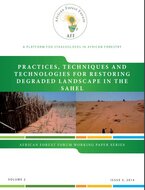The different agro-ecological zones of Sahelian countries have experienced continuous degradation for the last four decades due to the combined effects of drought, increasing anthropogenic pressure on the limited natural resources available, deforestation and
degradation of wood resources, reduced fallow period, intensification of cropping, overexploitation of water and pasture resources, etc. These malpractices have resulted in a decrease in the productivity of the prevailing Sahelian agro-silvo-pastoral land use systems. In response to this crisis, many international agencies and donor organisations have provided support to Governments and people in the Sahel aiming at developing technical, environmental and agricultural strategies and approaches for achieving sustainable and productive management of the environment and improving the quality of the different land resources. This support, mainly in response to the humanitarian and environmental crises that brought severe famine and resulted in the loss of large areas of cropland, rangeland and forestland, has focused on soil and water conservation and restoration techniques. Thus, many projects in these decades of recurrent droughts have developed activities related to land improvement and development practices and to natural resources conservation.
After these decades of drought and famine, and following the Earth Summit in Rio de Janeiro in 1992, most Sahelian countries have developed strategies and national action plans and programmes for combating desertification and for improved management of
natural resources in order to meet the commitments undertaken by signing and ratifying the Post-Rio international conventions, i.e. the Conventions for Combating Desertification (CCD), for Conserving Biological Diversity (CBD) and for mitigating Climate Change
(UNFCCC). As a result, issues of environmental degradation, including desertification and degradation of natural resources such as forests, woodlands and trees, have received increased international attention. In their efforts to implement these Multilateral Environmental Agreements (MEAs), most Sahelian countries have made significant progress in the fight against desertification, and for environmental protection and the rehabilitation of degraded lands, forests and woodlands. Much efforts has also been directed by countries towards technical, financial and institutional matters through implementation of several projects and programmes for desertification control, management of natural resources and improvement of income and living conditions of rural people. Various sustainable management techniques and practices, including farmer assisted natural regeneration, soil protection and conservation, and water conservation, have been implemented in the field. At the institutional level, Practices, techniques and technologies for restoring degraded landscapes in the sahel © African Forest Forum (August 2014) All Rights Reserved policies and strategies have been elaborated to strengthen countries commitment to implementing regional and international initiatives.
Restoration of degraded land is increasingly a key requirement in a context where food security is one of the main objectives for sustainable development of the countries. Many policies and strategies that were developed, and the action plans and programmes that are in place; focus on micro-economic interventions. These are are heavily subsidised and unfortunately, do not consider the broader policies. With the launching of the TerrAfrica process, Sustainable Land Management (SLM) is considered in most Sahelian countries as an imperative development tool for harmonising interventions within and between the major sub-sectors, such as agriculture, livestock, forestry, water resources and environment. It has been widely accepted that SLM can promote cross-sector integration, as recommended in the Agenda 21 and the Poverty Reduction Strategies elaborated and adopted by most Sahelian countries for achieving the Millennium Development Goals (MDGs). In fact, most Sahelian countries have elaborated and adopted sustainable investment frameworks for sustainable land management (SIFSLM) for scaling up and mainstreaming best practices, techniques and technologies in this domain. The main components of the SIF-SLM include:
providing adequate funding for scaling up SLM practices, techniques and technologies in the field, such as farmer managed natural regeneration, water harvesting technologies, soil fertility improvement techniques, afforestation, bush fire control measures, management of forests and protected areas, establishing flora and fauna reserves, elaboration and implementation of forest and woodland management plans, etc.;
strengthening the enabling environment for SLM practices, including improving institutional, political and financial support to SLM through: i) the implementation of a support programme for improving the institutional and financial capacities required for implementing SIF-SLM as a framework for National Strategies and Programmes for Food Security; ii) strengthening national mechanisms for SLM financial resource mobilisation from the coalition of financial and technical partners and others, mobilising relevant innovative funding sources, and increasing the national SLM budget; and, enhancing the legislative and regulatory environment for SLM by integratiing SLM into policies, strategies, projects and cross-sector programmes at all administrative levels;
enhancing the advisory roles of the technical services and improving the participation of the private sector in the implementation of best SLM practices, techniques and technologies through the development of harmonised planning and the promotion of marketable goods and services from SLM practices;
developing necessary tools for data collection, analysis and information dissemination to all local users and decision makers; Practices, techniques and technologies for restoring degraded landscapes in the sahel
formulating and implementing sound and appropriate communication strategy supporting the application of the SLM approaches and the adoption of best practices;
strengthening the capacities of all stakeholders in using SLM approaches, strategies, practices and techniques, and promote the implementation of SIF-SLM through various training sessions of all actors (civil society, private sector, local authorities, and public sector organisations of producers, etc.) involved in SLM;
providing adequate funding for the development and application of monitoring tools and SLM information systems, and building capacity for implementing them in order to allow stakeholders to better monitor land resource uses and changes and to transfer knowledge necessary for sustaining post-project impact, thereby contributing to greater adoption of climate-smart land, water and forest management.

